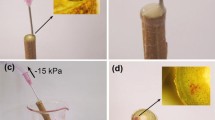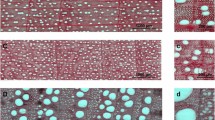Abstract
The main objective of this study was to evaluate the role of intervessel contacts in determining the patterns of hydraulic integration both within and between xylem sectors. The degree of intervessel contacts and the lateral exchange capability within and between sectors were examined and correlated in different xeric shrubs. A dye injection method was used to detect the connections between vessels; an apoplastic dye was sucked through a known number of vessels and its distribution in the xylem network was followed. Hydraulic techniques were used to measure axial and tangential conductivity both within and between xylem sectors. The intra- and inter-sector integration indexes were then determined as the ratio of tangential to axial conductance. Species differed significantly in the degree of intervessel contacts, intra- and inter-sector integration index. In all cases, hydraulic integration was observed to be higher within sector than between sectors. From the correlation analyses, the intervessel contacts showed a very weak relationship with inter-sector integration index and a strong positive relationship with intra-sector integration index. Results suggested that (1) the factors affecting patterns of lateral flow within xylem sectors might be relatively different from those between sectors. (2) The degree of intervessel contacts was a major determinant of hydraulic integration within the same xylem sector. (3) Intervessel connectivity alone was a poor predictor of hydraulic integration between different sectors, implying a significant contribution of other anatomical, physiological and environmental factors in determining the patterns of integrated–sectored transport within woody stems.





Similar content being viewed by others
References
Burggraaf PD (1972) Some observations on the course of the vessels in the wood of Fraxinus excelsior L. Acta Bot Neer 21:32–47
De Micco V, Aronne G (2008) Wood anatomy and hydraulic architecture of stems and twigs of some Mediterranean trees and shrubs along a mesic-xeric gradient. Trees 22:643–655
Ellmore GS, Zanne AE, Orians CM (2006) Comparative sectoriality in temperate hardwoods: hydraulics and xylem anatomy. Bot J Linn Soc 150:61–71
Fujii T, Lee SJ, Kuroda N, Suzuki Y (2001) Conductive function of intervessel pits through a growth ring boundary of Machilus thunbergii. IAWA J 22:1–14
Gloser V, Libera K, Orians CM (2008) Contrasting below- and aboveground responses of two deciduous trees to patchy nitrate availability. Tree Physiol 28:37–44
Halis Y, Djehichi S, Senoussi MM (2012) Vessel development and the importance of lateral flow in water transport within developing bundles of current-year shoots of grapevine (Vitis vinifera L.). Trees 26:705–714
Jones CS, Lord EM (1982) The development of split axes in Ambrosia dumosa (Gray) Payne (Asteraceae). Bot Gaz 143:446–453
Kitin PB, Fujii T, Abe H, Funada R (2004) Anatomy of the vessel network within and between tree rings of Fraxinus lanuginosa (Oleaceae). Am J Bot 91:779–788
Kitin P, Fujii T, Abe H, Takata K (2009) Anatomical features that facilitate radial flow across growth rings and from xylem to cambium in Cryptomeria japonica. Ann Bot 103:1145–1157
Larson PR (1994) The vascular cambium: structure and function. Springer, Berlin
McCulloh KA, Sperry JS (2005) Patterns in hydraulic architecture and their implications for transport efficiency. Tree Physiol 25:257–267
Nadezhdina N (2010) Integration of water transport pathways in a maple tree: responses of sap flow to branch severing. Ann For Sci 67:107
Orians CM, Jones CG (2001) Plants as resource mosaics: a functional model for predicting patterns of within-plant resource heterogeneity to consumers based on vascular architecture and local environmental variability. Oikos 94:493–504
Orians CM, van Vuuren MM, Harris NL, Babst BA, Ellmore GS (2004) Differential sectoriality in long distance transport in temperate tree species, evidence from dye flow, 15 N transport, and vessel element pitting. Trees 18:501–509
Orians CM, Smith SDP, Sack L (2005) How are leaves plumbed inside a branch? Differences in leaf-to-leaf hydraulic sectoriality among six temperate tree species. J Exp Bot 56:2267–2273
Pratt RB, Jacobsen AL, Ewers FW, Davis SD (2007) Relationships among xylem transport, biomechanics, and storage in stems and roots of nine Rhamnaceae species of the California chaparral. New Phytol 174:787–798
Schenk HJ (1999) Clonal splitting in desert shrubs. Plant Ecol 141:41–52
Schenk HJ, Espino S, Goedhart CM, Nordenstahl M, Cabrera HIM, Jones CS (2008) Hydraulic integration and shrub growth form linked across continental aridity gradients. Proc Natl Acad Sci USA 105:11248–11253
Schulte PJ (2006) Water flow through junctions in Douglas-fir roots. Plant Cell Environ 29:70–76
Schulte PJ, Brooks JR (2003) Branch junctions and the flow of water through xylem in Douglas-fir and ponderosa pine stems. J Exp Bot 54:1597–1605
Shane MW, McCully ME, Canny MJ (2000) Architecture of branch root junctions in maize: structure of the connecting xylem and the porosity of pit membranes. Ann Bot 85:613–624
Sperry JS, Hacke UG, Pittermann J (2006) Size and function in conifer tracheids and angiosperm vessels. Am J Bot 93:1490–1500
Sprugel DG, Hinckley TM, Schaap W (1991) The theory and practice of branch autonomy. Ann Rev Ecol Syst 22:309–334
Taneda H, Tateno M (2007) Effects of transverse movement of water in xylem on patterns of water transport within current-year shoots of kudzu vine, Pueraria lobata. Funct Ecol 21:226–234
Thorn AM, Orians CM (2011) Modeling the influence of differential sectoriality on the photosynthetic responses of understory saplings to patchy light and water availability. Trees 25:833–845
Tyree MT, Ewers FW (1991) The hydraulic architecture of trees and other woody plants. New Phytol 119:345–360
Tyree MT, Zimmermann MH (2002) Xylem structure and the ascent of sap, 2nd edn. Springer, Berlin
Tyree MT, Davis SD, Cochard H (1994) Biophysical perspective of xylem evolution: is there a tradeoff of hydraulic efficiency for vulnerability to disfunction? IAWA J 15:335–360
Umebayashi T, Utsumi Y, Koga S, Inoue S, Shiiba Y, Arakawa K, Matsumura J, Oda K (2007) Optimal conditions for visualizing water-conducting pathways in a living tree by the dye injection method. Tree Physiol 27:993–999
Waisel Y, Liphschitz N, Kuller Z (1972) Patterns of water movement in trees and shrubs. Ecology 53:520–523
Watson MA (1986) Integrated physiological units in plants. Trend Ecol Evol 1:119–123
Whalen MA (1987) Wood anatomy of the American Frankenias (Frankeniaceae): systematic and evolutionary implications. Amer J Bot 74:1211–1223
Zanne AE, Sweeney K, Sharma M, Orians CM (2006) Patterns and consequences of differential vascular sectoriality in 18 temperate trees and shrub species. Funct Ecol 20:200–206
Zanne AE, Westoby M, Falster DS, Ackerly DD, Loarie SR, Arnold SEJ, Coomes DA (2010) Angiosperm wood structure: global patterns in vessel anatomy and their relation to wood density and potential conductivity. Am J Bot 97:207–215
Zwieniecki MA, Melcher PJ, Holbrook NM (2001) Hydrogel control of xylem hydraulic resistance in plants. Science 29:1059–1062
Acknowledgments
We thank Abdelaziz Labidi and Belgacem Hadid for their support and assistance. Special thanks are extended to Drs. Mohamed Hocine Benaissa and Nouar Boulghabra for helpful comments and the anonymous referees for helpful comments on earlier versions of this manuscript. We are also grateful to Sofiane Amira, Ali Lahcini, Abdessalem Bougafla, Rachid Benhamed and Youcef Yacoubi for their technical support.
Author information
Authors and Affiliations
Corresponding author
Rights and permissions
About this article
Cite this article
Halis, Y., Mayouf, R., Benhaddya, M.L. et al. Intervessel connectivity and relationship with patterns of lateral water exchange within and between xylem sectors in seven xeric shrubs from the great Sahara desert. J Plant Res 126, 223–231 (2013). https://doi.org/10.1007/s10265-012-0514-6
Received:
Accepted:
Published:
Issue Date:
DOI: https://doi.org/10.1007/s10265-012-0514-6




